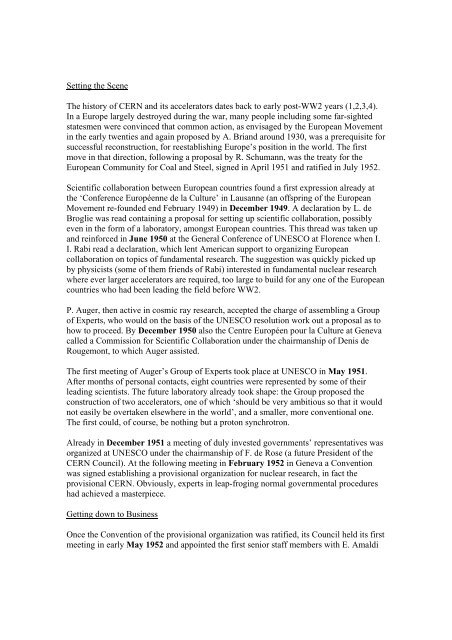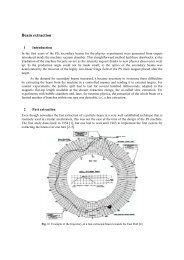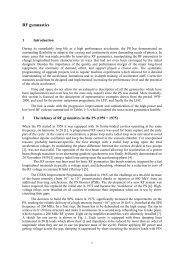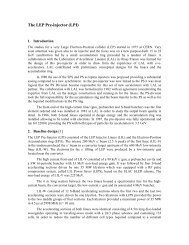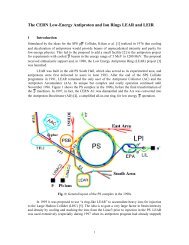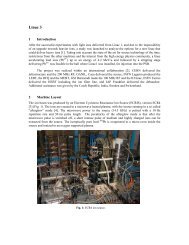Setting the Scene The history of CERN and its accelerators dates ...
Setting the Scene The history of CERN and its accelerators dates ...
Setting the Scene The history of CERN and its accelerators dates ...
Create successful ePaper yourself
Turn your PDF publications into a flip-book with our unique Google optimized e-Paper software.
<strong>Setting</strong> <strong>the</strong> <strong>Scene</strong><br />
<strong>The</strong> <strong>history</strong> <strong>of</strong> <strong>CERN</strong> <strong>and</strong> <strong>its</strong> <strong>accelerators</strong> <strong>dates</strong> back to early post-WW2 years (1,2,3,4).<br />
In a Europe largely destroyed during <strong>the</strong> war, many people including some far-sighted<br />
statesmen were convinced that common action, as envisaged by <strong>the</strong> European Movement<br />
in <strong>the</strong> early twenties <strong>and</strong> again proposed by A. Bri<strong>and</strong> around 1930, was a prerequisite for<br />
successful reconstruction, for reestablishing Europe’s position in <strong>the</strong> world. <strong>The</strong> first<br />
move in that direction, following a proposal by R. Schumann, was <strong>the</strong> treaty for <strong>the</strong><br />
European Community for Coal <strong>and</strong> Steel, signed in April 1951 <strong>and</strong> ratified in July 1952.<br />
Scientific collaboration between European countries found a first expression already at<br />
<strong>the</strong> ‘Conference Européenne de la Culture’ in Lausanne (an <strong>of</strong>fspring <strong>of</strong> <strong>the</strong> European<br />
Movement re-founded end February 1949) in December 1949. A declaration by L. de<br />
Broglie was read containing a proposal for setting up scientific collaboration, possibly<br />
even in <strong>the</strong> form <strong>of</strong> a laboratory, amongst European countries. This thread was taken up<br />
<strong>and</strong> reinforced in June 1950 at <strong>the</strong> General Conference <strong>of</strong> UNESCO at Florence when I.<br />
I. Rabi read a declaration, which lent American support to organizing European<br />
collaboration on topics <strong>of</strong> fundamental research. <strong>The</strong> suggestion was quickly picked up<br />
by physicists (some <strong>of</strong> <strong>the</strong>m friends <strong>of</strong> Rabi) interested in fundamental nuclear research<br />
where ever larger <strong>accelerators</strong> are required, too large to build for any one <strong>of</strong> <strong>the</strong> European<br />
countries who had been leading <strong>the</strong> field before WW2.<br />
P. Auger, <strong>the</strong>n active in cosmic ray research, accepted <strong>the</strong> charge <strong>of</strong> assembling a Group<br />
<strong>of</strong> Experts, who would on <strong>the</strong> basis <strong>of</strong> <strong>the</strong> UNESCO resolution work out a proposal as to<br />
how to proceed. By December 1950 also <strong>the</strong> Centre Européen pour la Culture at Geneva<br />
called a Commission for Scientific Collaboration under <strong>the</strong> chairmanship <strong>of</strong> Denis de<br />
Rougemont, to which Auger assisted.<br />
<strong>The</strong> first meeting <strong>of</strong> Auger’s Group <strong>of</strong> Experts took place at UNESCO in May 1951.<br />
After months <strong>of</strong> personal contacts, eight countries were represented by some <strong>of</strong> <strong>the</strong>ir<br />
leading scientists. <strong>The</strong> future laboratory already took shape: <strong>the</strong> Group proposed <strong>the</strong><br />
construction <strong>of</strong> two <strong>accelerators</strong>, one <strong>of</strong> which ‘should be very ambitious so that it would<br />
not easily be overtaken elsewhere in <strong>the</strong> world’, <strong>and</strong> a smaller, more conventional one.<br />
<strong>The</strong> first could, <strong>of</strong> course, be nothing but a proton synchrotron.<br />
Already in December 1951 a meeting <strong>of</strong> duly invested governments’ representatives was<br />
organized at UNESCO under <strong>the</strong> chairmanship <strong>of</strong> F. de Rose (a future President <strong>of</strong> <strong>the</strong><br />
<strong>CERN</strong> Council). At <strong>the</strong> following meeting in February 1952 in Geneva a Convention<br />
was signed establishing a provisional organization for nuclear research, in fact <strong>the</strong><br />
provisional <strong>CERN</strong>. Obviously, experts in leap-froging normal governmental procedures<br />
had achieved a masterpiece.<br />
Getting down to Business<br />
Once <strong>the</strong> Convention <strong>of</strong> <strong>the</strong> provisional organization was ratified, <strong>its</strong> Council held <strong>its</strong> first<br />
meeting in early May 1952 <strong>and</strong> appointed <strong>the</strong> first senior staff members with E. Amaldi
as <strong>the</strong> Secretary General. Four Study Groups were established: <strong>The</strong>ory under N. Bohr,<br />
Laboratory services under L. Kowarski, Synchrocyclotron under C. Bakker, <strong>and</strong> Proton<br />
Synchrotron under O. Dahl with F. Goward as deputy. Fur<strong>the</strong>r members <strong>of</strong> <strong>the</strong> PS Group<br />
were H. Alfvén, J. Fry, W. Gentner, K. Johnsen, E. Regenstreif, Chr. Schmelzer <strong>and</strong> R.<br />
Wideröe. From here on we shall follow in some detail <strong>the</strong> activities <strong>of</strong> <strong>the</strong> latter group.<br />
At end June 1952 <strong>the</strong> PS Group presented a first proposal for <strong>the</strong> construction <strong>of</strong> a 10 to<br />
15 GeV proton synchrotron, intended to be an up-scaled version <strong>of</strong> <strong>the</strong> 3 GeV Cosmotron<br />
at Brookhaven, which just had accelerated protons to more than 1 GeV in May <strong>of</strong> that<br />
year. Council asked that a detailed design <strong>and</strong> planning for a 10 GeV machine be<br />
presented by November 1953.<br />
Three members <strong>of</strong> <strong>the</strong> group, Dahl, Goward <strong>and</strong> Wideröe, visited Brookhaven during <strong>the</strong><br />
first two weeks <strong>of</strong> August 1952 so as to learn about details <strong>of</strong> <strong>the</strong> Cosmotron. <strong>The</strong><br />
Cosmotron team discussed, in anticipation <strong>of</strong> <strong>the</strong> visit, possible improvements to <strong>the</strong>ir<br />
machine design, <strong>and</strong> discovered during <strong>the</strong>se reflections a new way <strong>of</strong> beam focusing (5).<br />
<strong>The</strong> visitors were thus introduced, to <strong>the</strong>ir great surprise, to a br<strong>and</strong>-new idea, alternatinggradient<br />
or ‘strong’ focusing <strong>of</strong> particle beams, which would reduce by a large factor <strong>the</strong><br />
size <strong>of</strong> <strong>the</strong> vacuum chamber containing <strong>the</strong> beam <strong>and</strong> hence <strong>the</strong> magnet providing <strong>the</strong><br />
guide field. An accelerator <strong>of</strong> higher energy could thus be built within a given budget.<br />
Upon returning home <strong>the</strong> PS Group was faced with a very difficult decision: going ahead<br />
on <strong>the</strong> proven trail (which anyway was new territory for most <strong>of</strong> <strong>the</strong>m) or changing<br />
course <strong>and</strong> proceed with <strong>the</strong> new <strong>and</strong> untried idea. It might have been a deadly blow to<br />
<strong>the</strong> young team if <strong>the</strong>y found <strong>the</strong>mselves in a dead alley. But one could also hope that a<br />
machine <strong>of</strong> classical design might in this case‘ only’ be delayed by a year or so. O. Dahl<br />
strongly advocated an intense study <strong>of</strong> <strong>the</strong> strong focusing system <strong>and</strong> obtained Council<br />
approval at <strong>its</strong> third session in October 1952 at Amsterdam, which also saw <strong>the</strong> decision<br />
for Geneva as <strong>the</strong> location <strong>of</strong> <strong>the</strong> future laboratory.<br />
O. Dahl in his presentation to Council gave due warning <strong>of</strong> <strong>the</strong> risks involved in that<br />
choice but pointed out that a project based on <strong>the</strong> ‘classical’ design could not now be<br />
defended in view <strong>of</strong> <strong>the</strong> possible advantages inherent in <strong>the</strong> new invention. In fact, it was<br />
expected that a synchrotron <strong>of</strong> 30 GeV might be built at <strong>the</strong> same cost as a Cosmotrontype<br />
machine <strong>of</strong> 10 GeV (for which however no reliable cost estimate existed at that<br />
moment).<br />
<strong>The</strong> successful development <strong>of</strong> <strong>CERN</strong> during more than 5 decades was largely due to <strong>the</strong><br />
surprising flexibility <strong>of</strong> <strong>the</strong> alternating-gradient PS. <strong>CERN</strong> would surely have developed<br />
in a very different way, had this courageous decision not been taken.<br />
In fact, as <strong>the</strong> <strong>the</strong>ory <strong>of</strong> <strong>the</strong> alternating gradient synchrotron was developed, two serious<br />
problems were soon discovered: first, <strong>the</strong> stronger <strong>the</strong> focusing, <strong>the</strong> higher a precision <strong>of</strong><br />
<strong>the</strong> magnet field <strong>and</strong> <strong>of</strong> <strong>the</strong> alignment <strong>of</strong> <strong>the</strong> magnets is required. If <strong>the</strong> tight tolerances<br />
were not met, <strong>the</strong> beam would be lost due to resonance blow-up <strong>of</strong> <strong>the</strong> ‘betatron’<br />
oscillations <strong>of</strong> <strong>the</strong> protons about <strong>the</strong> equilibrium orbit (6). Secondly, <strong>the</strong> beam looses
longitudinal stability at a point <strong>of</strong> <strong>the</strong> acceleration cycle, <strong>the</strong> ‘transition energy’, when <strong>the</strong><br />
relative increase in particle velocity changes from being greater to being smaller than <strong>the</strong><br />
variation <strong>of</strong> orbit length.<br />
Several ma<strong>the</strong>matical physicists (7,8,9,10,11) joined in to analyze <strong>the</strong> sensitivity <strong>of</strong> <strong>the</strong><br />
betatron oscillations to field errors <strong>and</strong> <strong>the</strong> lim<strong>its</strong> <strong>of</strong> <strong>the</strong>ir stability. A mechanical analogue<br />
model for some experimental work was developed as well (12). <strong>The</strong> problem <strong>of</strong> <strong>the</strong> loss<br />
<strong>of</strong> phase stability was to first approximation solved by a jump <strong>of</strong> <strong>the</strong> acceleration phase<br />
angle <strong>and</strong> has been studied in great detail K. Johnsen (13-5,15-6). Still, it remained a<br />
subject <strong>of</strong> deeper study <strong>and</strong> several improvements as <strong>the</strong> beam intensity was increased<br />
during <strong>the</strong> whole life <strong>of</strong> <strong>the</strong> PS.<br />
In <strong>the</strong> meantime more scientists were seconded by <strong>the</strong>ir home laboratories to <strong>the</strong> PS<br />
Group, amongst <strong>the</strong>m J. B. Adams, A. Citron, P. Grivet, M. G. N. Hine, J. C. Jacobsen, J.<br />
Lawson <strong>and</strong> G. Lüders, <strong>and</strong>, very importantly, two colleagues from <strong>the</strong> Brookhaven<br />
Laboratory, Hildred <strong>and</strong> John Blewett. Several design options with different focusing<br />
gradients were explored resulting in magnet masses between 800 <strong>and</strong> 10 000 tons or more<br />
for a 30 GeV synchrotron. However, <strong>the</strong> precision required in machining <strong>of</strong> <strong>the</strong> pole<br />
pr<strong>of</strong>ile <strong>and</strong> <strong>of</strong> <strong>the</strong> overall alignment <strong>of</strong> an accelerator with <strong>the</strong> smallest magnet turned out<br />
quite impossible. As result <strong>of</strong> several iterations, <strong>the</strong> design converged on a machine <strong>of</strong> 30<br />
GeV beam energy at a magnet field <strong>of</strong> 12 kG (1.2 T), <strong>and</strong> an average radius <strong>of</strong> 112 m.<br />
<strong>The</strong> focusing strength chosen required a vacuum chamber <strong>of</strong> 12 cm full width <strong>and</strong> 8 cm<br />
height, with magnets <strong>of</strong> about 4000 tons total mass.<br />
As from January 1953 work on <strong>the</strong> Convention <strong>of</strong> a final organization (as opposed to <strong>the</strong><br />
provisional convention in force since nine months) was launched. It was signed <strong>and</strong><br />
submitted for ratification by <strong>the</strong> member states by end June 1953. So as to keep track <strong>of</strong><br />
<strong>the</strong> developments, <strong>the</strong> PS group was asked to organize a meeting with international<br />
accelerator experts. Thus in October 1953 <strong>the</strong> ‘Conference on <strong>the</strong> Alternating Gradient<br />
Proton Synchrotron’ was held at Geneva, which was attended by Council members <strong>and</strong><br />
many European <strong>and</strong> American scientists. In addition to <strong>the</strong> papers by <strong>the</strong> PS Group (13)<br />
on <strong>the</strong> design <strong>of</strong> <strong>the</strong> 30 GeV machine <strong>and</strong> aspects <strong>of</strong> beam dynamics, W. Heisenberg was<br />
asked to present <strong>the</strong> users’ view as to <strong>the</strong> beam energy required. He recommended to ‘<br />
build a machine that could be operated without difficulty in <strong>the</strong> region somewhat above<br />
20 GeV but which could, in <strong>the</strong> limit, be extended in energy to 30 GeV’.<br />
After <strong>the</strong> conference, Council, satisfied by <strong>the</strong> very positive response to <strong>the</strong> work <strong>of</strong> <strong>the</strong><br />
PS Group, gave green light to building an AG proton synchrotron with nominal beam<br />
energy <strong>of</strong> 25 GeV at 12 kG <strong>and</strong> 3 s cycle time (which could in fact at reduced repetition<br />
rate be driven up to 28 GeV) at a cost provisionally estimated at 130 MSF. Council also<br />
approved <strong>the</strong> proposal that <strong>the</strong> PS Study Group should move to Geneva <strong>and</strong> nominated a<br />
‘chief architect’ (R. Steiger from Zürich) so that construction work on <strong>the</strong> site could be<br />
organized without delay. Group members could use temporary <strong>of</strong>fices <strong>and</strong> a hall for<br />
experimental work made available at <strong>the</strong> Institut de Physique (where some barracks were<br />
added) <strong>and</strong> – with <strong>the</strong> exception <strong>of</strong> Dahl – began moving <strong>the</strong>ir families to Geneva.<br />
Collaboration between <strong>the</strong>m was <strong>of</strong> course enormously improved.
At Brookhaven <strong>the</strong> construction <strong>of</strong> a similar machine, <strong>the</strong> AGS, was authorized shortly<br />
afterwards, including a small-scale model electron synchrotron, which provided an<br />
experimental demonstration <strong>of</strong> <strong>the</strong> feasibility <strong>of</strong> going through <strong>the</strong> transition energy. A<br />
friendly competition for years to come developed between <strong>the</strong> teams building <strong>the</strong> two<br />
machines, with full exchange <strong>of</strong> information.<br />
Construction <strong>of</strong> <strong>the</strong> PS<br />
Once Council had decided <strong>the</strong> basic parameters <strong>of</strong> <strong>the</strong> machines to be built, work on <strong>the</strong>ir<br />
realization could begin. But also <strong>the</strong> infrastructure <strong>of</strong> a future laboratory– personnel <strong>and</strong><br />
purchasing <strong>of</strong>fices, site <strong>and</strong> safety management – had to be set up <strong>and</strong> recruitment <strong>of</strong> staff<br />
at all levels <strong>and</strong> from all member states had to be organized. Thus <strong>the</strong> responsibility for a<br />
quite unusual large-scale operation was entrusted to <strong>the</strong> two dozen or so members <strong>of</strong> <strong>the</strong><br />
provisional <strong>CERN</strong>, <strong>of</strong> whom few had industrial or managerial experience.<br />
While <strong>the</strong> parameters <strong>of</strong> <strong>the</strong> PS were fur<strong>the</strong>r refined for cost <strong>and</strong> performance, a realistic<br />
project planning had to be set up. All components <strong>of</strong> <strong>the</strong> synchrotron had to be designed<br />
ab initio with very few precedents, which might have been copied, existing. Preliminary<br />
design work <strong>of</strong> <strong>the</strong> main components, <strong>the</strong> magnet, RF acceleration system <strong>and</strong> <strong>the</strong><br />
injection linac had already been undertaken at, respectively, O. Dahl’s laboratory in<br />
Bergen, Pr<strong>of</strong>. Grivet’s laboratory in Paris, <strong>the</strong> University <strong>of</strong> Heidelberg, <strong>and</strong> at <strong>the</strong><br />
Harwell laboratory. All <strong>of</strong> that work <strong>and</strong> <strong>the</strong> staff were transferred to Geneva during<br />
1954. By September, PS staff numbers had grown to 54 persons <strong>and</strong> on <strong>the</strong> 29 th <strong>of</strong><br />
September 1954 <strong>the</strong> <strong>CERN</strong> Convention came into operation. O. Dahl resigned in<br />
October <strong>and</strong> was replaced by J. B. Adams who became <strong>the</strong>n Director <strong>of</strong> <strong>the</strong> PS Division.<br />
<strong>The</strong> final parameters <strong>of</strong> <strong>the</strong> PS were adopted in December 1954 (14). <strong>The</strong> number <strong>of</strong><br />
betatron oscillation cycles per revolution was set at Q=6.25, with a magnet field gradient<br />
corresponding to a ‘field index’ <strong>of</strong> n=282. (<strong>The</strong> latter was initially thought to be as high<br />
as n=4000.) <strong>The</strong> elliptical aperture <strong>of</strong> <strong>the</strong> vacuum chamber is 8 x 15 cm, <strong>the</strong> magnet pole<br />
width is 36 cm <strong>and</strong> <strong>the</strong> total steel mass <strong>of</strong> <strong>the</strong> 100 magnet un<strong>its</strong> is 3200 tons. Around <strong>the</strong><br />
circumference, 628 meters, <strong>the</strong>re are 100 magnet un<strong>its</strong> <strong>of</strong> 4.4 m nominal length, 80 short<br />
straight sectors <strong>of</strong> 1.6 m, <strong>and</strong> 20 straight sectors <strong>of</strong> 3 m. Sixteen long straights were to be<br />
equipped with acceleration cavities, 20 short ones with quadrupole correction lenses, <strong>and</strong><br />
20 short ones with sets <strong>of</strong> sextupole <strong>and</strong> octopole lenses. O<strong>the</strong>r straights were reserved<br />
for beam observation stations <strong>and</strong> injection devices, targets <strong>and</strong> (later) ejection magnets.<br />
<strong>The</strong> energy <strong>of</strong> <strong>the</strong> injected beam was set at 50 MeV, corresponding to a magnet field <strong>of</strong><br />
140 Gauss. As <strong>the</strong> field gradient varies due to remanent fields at low field levels <strong>and</strong> due<br />
to saturation at high fields, each magnet is equipped with correcting pole-face windings.<br />
<strong>The</strong> target date for finishing <strong>the</strong> project was set at end 1959.
Not much time was left for <strong>the</strong> groups responsible for <strong>the</strong> large number <strong>of</strong> machine<br />
components to produce <strong>the</strong> final design <strong>of</strong> all machine components which had to be<br />
developed, prototypes made <strong>and</strong> tested, <strong>and</strong> specifications written; finally contracts had<br />
to be awarded, production in industry supervised <strong>and</strong> <strong>the</strong> final products be tested.<br />
Consequently, <strong>the</strong> staff <strong>of</strong> <strong>the</strong> PS division was increased substantially, reaching 143 by<br />
end 1956.<br />
At <strong>the</strong> ‘<strong>CERN</strong> Symposium on High Energy Accelerators <strong>and</strong> Pion Physics’, still held at<br />
<strong>the</strong> Institut de Physique in June 1956, several papers related to <strong>the</strong> PS (15) were<br />
presented. This conference put <strong>CERN</strong> definitely on <strong>the</strong> world map <strong>of</strong> research institutions<br />
for fundamental physics. <strong>The</strong> Linac group moved into a small hall, appropriately called<br />
‘Adam’s Hall’, on <strong>the</strong> Meyrin site already in 1955, but all o<strong>the</strong>rs continued to work in<br />
town until <strong>the</strong> on-site <strong>of</strong>fices got ready in early 1957. Magnets <strong>and</strong> power supplies, RF<br />
cavities <strong>and</strong> transmitters, vacuum chambers <strong>and</strong> pumping stations, controls, beam<br />
observation stations, much electronics <strong>and</strong> cables have to come toge<strong>the</strong>r to make an<br />
accelerator. <strong>The</strong>re is not space in this review chapter to comment on more than a<br />
selection <strong>of</strong> <strong>the</strong>se systems.<br />
<strong>The</strong> development <strong>of</strong> <strong>the</strong> acceleration system (13-5,15-7,16) has been undertaken at<br />
Heidelberg back in 1952 <strong>and</strong> has been relocated to Geneva in 1954. Measurements first<br />
on small-scale models <strong>and</strong>, as from end 1955, on a full-scale cavity prototype served as<br />
basis for <strong>the</strong> development <strong>of</strong> wide-b<strong>and</strong> power amplifiers, AVC systems <strong>and</strong> <strong>the</strong> tuning<br />
system between 5 <strong>and</strong> 16 MHz. Contracts for 16 acceleration un<strong>its</strong> (plus spares) <strong>and</strong> all<br />
ancillary equipment were placed as from November 1956. All <strong>the</strong> control electronics<br />
were installed in a building at <strong>the</strong> ring center, <strong>and</strong> all acceleration cavities in <strong>the</strong> ring, by<br />
August1959.<br />
It may be interesting to illustrate in some more detail some <strong>of</strong> <strong>the</strong> procedures followed by<br />
<strong>the</strong> Magnet group (13-8,13-9,15-8) in order to satisfy <strong>the</strong> tight tolerances on fields <strong>and</strong><br />
gradients. <strong>The</strong> main magnet consists <strong>of</strong> 100 un<strong>its</strong>, 30 tons each <strong>and</strong> made out <strong>of</strong> 10 blocks<br />
with a common excitation winding. Extensive tests <strong>of</strong> several types <strong>of</strong> steel had been<br />
made in previous years, so that a low-carbon type steel could be selected with confidence<br />
for reasons <strong>of</strong> mechanical properties <strong>and</strong> price. Similarly, <strong>the</strong> model work since 1952<br />
permitted <strong>the</strong> correct pole pr<strong>of</strong>ile for <strong>the</strong> chosen field index to be readily determined. <strong>The</strong><br />
specifications for production were ready in May 1956. In order to guarantee <strong>the</strong> required<br />
field uniformity around <strong>the</strong> orbit, an extensive 2-stage mixing procedure was<br />
implemented.<br />
As it is very difficult to control <strong>the</strong> magnetic properties <strong>of</strong> raw steel, <strong>the</strong> 1.5 mm thick<br />
steel sheets coming from <strong>the</strong> mill were laid out in some 260 piles in <strong>the</strong> manufacturer’s<br />
hall. When all <strong>the</strong> raw steel production was finished one sheet <strong>of</strong> each pile was picked up<br />
<strong>and</strong> precisely cut to dimension. <strong>The</strong>y were glued toge<strong>the</strong>r to form a block (3 tons) thus<br />
containing material from <strong>the</strong> whole production quantity, <strong>and</strong> delivered to <strong>CERN</strong>. At<br />
<strong>CERN</strong>, <strong>the</strong> magnetic characteristics were measured <strong>and</strong> <strong>the</strong> remanent field <strong>and</strong> <strong>the</strong><br />
saturation characteristics recorded. When all <strong>the</strong> blocks had arrived, been measured <strong>and</strong><br />
stored, <strong>the</strong>y were selected so that <strong>the</strong>se characteristics averaged out for each batch <strong>of</strong> ten
locks <strong>and</strong> assembled to form, equipped with coils <strong>and</strong> pole face windings, un<strong>its</strong> with<br />
equal magnetic properties.<br />
Magnet blocks were delivered from fall 1957 to summer 1958. Magnet un<strong>its</strong> were<br />
installed from fall 1958 to June 1959. As soon as <strong>the</strong> South experimental hall was partly<br />
finished in early 1957, <strong>the</strong> Magnet group set up measuring benches <strong>and</strong> motor-generator<br />
sets for measuring <strong>the</strong> 1000 blocks coming out <strong>of</strong> <strong>the</strong> production line as well as <strong>the</strong> 100<br />
magnet un<strong>its</strong> into which <strong>the</strong> blocks were assembled.<br />
Civil Engineering operations on site began already in May 1953, (even before ratification<br />
<strong>of</strong> <strong>the</strong> Convention!) notably with <strong>the</strong> exploration <strong>of</strong> <strong>the</strong> underground by digging shafts<br />
<strong>and</strong> by test borings, so that <strong>the</strong> best position within <strong>the</strong> available site could be determined<br />
<strong>and</strong> <strong>the</strong> support structure designed. It was found that <strong>the</strong> underlying Molasse rock was<br />
closest to <strong>the</strong> surface in <strong>the</strong> West corner <strong>of</strong> <strong>the</strong> site. Observations showed <strong>the</strong> Molasse to<br />
be sufficiently stable to found <strong>the</strong> machine, via pillars, on it, whereas <strong>the</strong> superficial<br />
moraine layers showed a ‘breathing’ (2 to 3 mm over 100 meters) depending on <strong>the</strong><br />
amount <strong>of</strong> rain. A support system (17) was hence designed where <strong>the</strong> magnet un<strong>its</strong> are<br />
placed on a ring beam, supported through elastic coupling elements (which would isolate<br />
<strong>the</strong> ring from vibrations due e.g. to earthquakes) on pillars founded on <strong>the</strong> rock.<br />
Construction <strong>of</strong> <strong>the</strong> PS ring building began in <strong>the</strong> second half <strong>of</strong> 1955 <strong>and</strong> was finished<br />
by mid 1957. Special care was taken for <strong>the</strong> concrete ring beam <strong>of</strong> about 2 x 2 m2 crosssection<br />
on which <strong>the</strong> magnet un<strong>its</strong> are placed. <strong>The</strong> composition <strong>of</strong> <strong>the</strong> concrete, chosen<br />
for minimal shrinkage, was controlled with utmost care all around <strong>the</strong> circumference <strong>and</strong><br />
water pipes placed in it so that <strong>the</strong> uniformity <strong>of</strong> <strong>its</strong> temperature could be controlled<br />
continuously. In addition <strong>the</strong> tunnel air was (<strong>and</strong> still is) carefully controlled. At least a<br />
six 6 months settling time was respected before loading it with magnet un<strong>its</strong>.<br />
Surveying (18) to a precision <strong>of</strong> better than a millimeter a delicate machine structure<br />
inside a ring-shaped underground building <strong>of</strong> 200m diameter posed new problems for <strong>the</strong><br />
art <strong>of</strong> long-distance survey. Eight radial tunnels were provided facing a survey monument<br />
at <strong>the</strong> machine circumference each, as well as a central pillar below <strong>the</strong> ring central<br />
building. <strong>The</strong> distances between <strong>the</strong> pillars were measured with <strong>the</strong> help <strong>of</strong> invar steel<br />
wires calibrated against a st<strong>and</strong>ard base in one <strong>of</strong> <strong>the</strong> radial tunnels, <strong>the</strong> readings being<br />
taken with measuring microscopes. <strong>The</strong> magnet un<strong>its</strong> were than placed with respect to <strong>the</strong><br />
8 circumferential pillars. Needless to say that tunnel access was forbidden for those not<br />
concerned during <strong>the</strong> survey campaigns.<br />
<strong>The</strong> injection energy <strong>of</strong> <strong>the</strong> synchrotron is determined by a balance between <strong>the</strong> lowest<br />
acceptable magnet field, <strong>the</strong> tuning range <strong>of</strong> <strong>the</strong> acceleration cavities <strong>and</strong> <strong>the</strong> acceptable<br />
beam blow-up on <strong>the</strong> one h<strong>and</strong>, <strong>and</strong> by <strong>the</strong> cost <strong>of</strong> <strong>the</strong> injector on <strong>the</strong> o<strong>the</strong>r h<strong>and</strong>. It was<br />
clear from <strong>the</strong> beginning that an Alvarez-type linac, similar to <strong>the</strong> 50 MeV linac <strong>the</strong>n<br />
under construction for <strong>the</strong> Harwell laboratory, would be used as injector. Fortunately, <strong>the</strong><br />
idea that strong focusing would vastly improve linac performance (15-4,19) was<br />
immediately implemented avoiding <strong>the</strong> cumbersome ‘grid focusing’ <strong>of</strong> <strong>the</strong> earlier<br />
machines at Berkeley. Beam to <strong>the</strong> linac is provided by an ion source in a 500 kV pre-
accelerator. <strong>The</strong> linac consists <strong>of</strong> 3 tanks accelerating to 10 MeV, from 10 to 30 MeV <strong>and</strong><br />
to <strong>the</strong> injection energy <strong>of</strong> 50 MeV. While much <strong>of</strong> <strong>the</strong> early design was made at <strong>the</strong><br />
Harwell laboratory, <strong>the</strong> resonator structure <strong>and</strong> <strong>the</strong> vacuum envelope <strong>of</strong> Tank 1 were<br />
delivered to Adams’ Hall at end 1956 where <strong>the</strong>y were assembled. <strong>The</strong> tank was<br />
equipped with drift tubes containing pulsed quadrupoles <strong>and</strong> extensively tested toge<strong>the</strong>r<br />
with <strong>the</strong> RF power source. Tanks 2 <strong>and</strong> 3 were delivered directly to <strong>the</strong>ir final position in<br />
<strong>the</strong> linac building.<br />
By August1959 all elements <strong>of</strong> <strong>the</strong> synchrotron had been installed, <strong>the</strong> vacuum chamber<br />
closed <strong>and</strong> pumped down to some 10-5 torr, considered as <strong>the</strong> best vacuum that could be<br />
achieved on a large scale at that time. <strong>The</strong> injector linac began to produce a 50 MeV<br />
beam by end August, <strong>the</strong> first circulating beam in <strong>the</strong> PS was obtained by mid September<br />
1959 <strong>and</strong> <strong>the</strong> first acceleration to <strong>the</strong> design energy <strong>of</strong> 24 GeV was achieved on <strong>the</strong><br />
24 th <strong>of</strong> November 1959, one month before <strong>the</strong> set target date. <strong>The</strong> <strong>CERN</strong> Proton<br />
Synchrotron was ready for more than 5 decades <strong>of</strong> reliable operation, continued<br />
improvement <strong>and</strong> unexpected developments, very exciting to all those involved.<br />
References<br />
1.) A. Hermann, J. Kriege, U. Mers<strong>its</strong>, D. Pestre <strong>The</strong> History <strong>of</strong> <strong>CERN</strong><br />
North Holl<strong>and</strong> 1987<br />
2.) L. Kowarski, <strong>The</strong> Origin <strong>and</strong> Beginnings <strong>of</strong> <strong>CERN</strong><br />
<strong>CERN</strong> 61-10<br />
3.) E. Amaldi, <strong>CERN</strong>, <strong>the</strong> European Council for Nuclear Research<br />
Nuovo Cimento, suppl. 2, 1955<br />
4.) J. B. Adams, O. Dahl <strong>and</strong> <strong>the</strong> Machine at <strong>CERN</strong><br />
Festskrift til Odd Dahl, Bergen 1968<br />
5.) E. D. Courant, M. S. Livingston, H. S. Snyder <strong>The</strong> strong-Focusing Synchrotron<br />
Phys. Review 88 (1952)<br />
6.) J. B. Adams, M.N.G. Hine, J.D. Lawson, Effect <strong>of</strong> magnetic inhomogeneities in<br />
<strong>the</strong> Alternating gradient synchrotron Nature(London) 171 (1953)<br />
7.) T. Sigurgeirsson, Focusing in a synchrotron with periodic field<br />
<strong>CERN</strong> 55 –14<br />
8.) G. Lüders, <strong>The</strong>ory <strong>of</strong> particle orb<strong>its</strong> in <strong>the</strong> alternating gradient sychrotron<br />
<strong>CERN</strong> 55 – 24<br />
dto, Influence <strong>of</strong> irregularities <strong>of</strong> magnetic field on betatron oscillations
<strong>CERN</strong> 56 - 8<br />
9.) H. Steinwedel, Particle orb<strong>its</strong> in circular <strong>accelerators</strong><br />
<strong>CERN</strong> 56 – 20<br />
10.) R. Hagedorn, Stability <strong>of</strong> two-dimensional oscillations with periodic hamiltonian<br />
<strong>CERN</strong> 57 – 14<br />
11.) A. Schoch, <strong>The</strong>ory <strong>of</strong> linear <strong>and</strong> non-linear perturbations <strong>of</strong> betatron oscillations<br />
<strong>CERN</strong> 57 – 21<br />
12.) M. Barbier, Closed orbit ananlyzer<br />
<strong>CERN</strong> 59 – 31<br />
dto., Etude du movement d’un oscillateur anharmonic<br />
<strong>CERN</strong> 59 – 36<br />
13.) Lectures presented at <strong>the</strong> Conference on <strong>the</strong> Alternating Gradient Synchrotron,<br />
Ed. M.H. Blewett; <strong>CERN</strong> PS Group, 1953<br />
13-1) O.Dahl, Review <strong>of</strong> <strong>the</strong> <strong>CERN</strong>-Project<br />
13-2) F.K. Goward, Review <strong>of</strong> <strong>the</strong> principles leading to design <strong>the</strong> <strong>CERN</strong>-PS<br />
13-3) G. Lüders Linear <strong>the</strong>ory <strong>of</strong> betatron oscillations<br />
13-4) M.G.N. Hine, Topics on nonlinear orbit <strong>the</strong>ory<br />
13-5) K. Johnsen, Phase oscillations <strong>and</strong> transition energy problems<br />
13-6) J.B. Adams, Design <strong>of</strong> an AGS based on linear <strong>the</strong>ory<br />
13-7) C. Schmelzer, Radio-frequency system<br />
13-8) P. Grivet, E. Regenstreif, Magnet studies, part I<br />
13-9) J.C. Jacobsen, Magnet studies, part II<br />
13-10) A. Citron, Shielding requirements<br />
14.) E. Regenstreif, <strong>The</strong> <strong>CERN</strong> Alternating Gradient Synchrotron, 3 vol.<br />
<strong>CERN</strong> 59 – 25, 60 – 26, 62 – 03<br />
15.) Proceedings <strong>of</strong> <strong>the</strong> <strong>CERN</strong> Symposium on Accelerators <strong>and</strong> Pion Physics<br />
Ed. E. Regenstreif, <strong>CERN</strong> 1956<br />
Contributions concerning <strong>the</strong> <strong>CERN</strong> PS:<br />
15-1) M. Barbier, A mechanical analog for <strong>the</strong> study <strong>of</strong> betatron oscillations<br />
15-2) A. Citron, Ejection problems for <strong>the</strong> <strong>CERN</strong>-AG machine<br />
15-3) R. Hagedorn, M.G.N. Hine, Nonlinear orbit problems in synchrotrons<br />
15-4) H.G. Hereward, K. Johnsen, Alternating gradient focusing in linacs<br />
15-5) H.G. Hereward, K. Johnsen, P,Lapostolle, Problems <strong>of</strong> injection<br />
15-6) K. Johnsen, Effects <strong>of</strong> nonlinearities on <strong>the</strong> phase-transition<br />
15-7) K. Johnsen, C. Schmelzer, Beam controlled acceleration in synchrotrons<br />
15-8) PS-Magnet Group, pres. by C.A. Ramm , L’electro-aimant d’un AGS<br />
15-9) E. Regenstreif, Quelques effets de courbure dans le PS<br />
16.) C. Schmelzer,Das Europäische Gemeinschaftsproject eines 25 GeV Synchrotrons<br />
Physikertagung Innsbruck, 1953, Physik-Verlag Mosbach (Baden) 1954<br />
17.) J.B. Adams, <strong>The</strong> design <strong>of</strong> <strong>the</strong> foundations for <strong>the</strong> magnet <strong>of</strong> <strong>the</strong> CPS<br />
<strong>CERN</strong> 56 – 21<br />
18.) A.E. Decae, Geodetic Survey <strong>of</strong> <strong>the</strong> CPS<br />
<strong>CERN</strong> 60 – 19<br />
19.) J.P. Blewett, Radial focusing in <strong>the</strong> Linear Accelerator<br />
Phys. Review 88 (1952)


